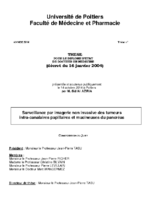Thèse d'exercice
Aziria Sid Ali
Surveillance par imagerie non invasive des tumeurs intra-canalaires papillaires et mucineuses du pancréas
FrançaisConsulter le texte intégral (format PDF)

Résumé
Français
Surveillance par imagerie non invasive des tumeurs intra-canalaires papillaires et mucineuses du pancréas
Introduction :
L'incidence des tumeurs intra-canalaires papillaires et mucineuses du pancréas (TIPMP) a augmenté avec les progrès de la tomodensitométrie (TDM) et de l'imagerie par résonance magnétique (IRM). L'objectif de cette étude est d'évaluer la performance de ces examens dans le suivi de cette pathologie.
Matériel et méthodes :
Une étude rétrospective a été réalisée au CHU de Poitiers incluant les TIPMP diagnostiquées entre 2004 et 2014. Le diagnostic du caractère bénin ou malin a été retenu sur l'histologie si elle était disponible ou sur la survie à 2 ans, synonyme de bénignité. Le critère d'évaluation principal était la performance diagnostique pour la caractérisation bénin-malin de l'imagerie non invasive (TDM et IRM). Les critères d'évaluation secondaires étaient la comparaison de cette performance à celle de l'écho-endoscopie (EUS) et l'apport des séquences de diffusion (SD) en IRM.
Résultats :
Parmi 116 patients éligibles, 40 ont été inclus. 19 ont bénéficié d'une vérification histologique et 21 ont été surveillés pendant au moins 2 ans. Les performances de l'imagerie pour le diagnostic du caractère bénin ou malin étaient une sensibilité de 100% (IC 95%=0.69-1) et une spécificité de 76,7% (IC 95%= 0.58-0.90), comparables à celles de l'EUS. La SD présentait une spécificité de 96 % (IC95% : 0.80-1). Les tumeurs malignes étaient volontiers symptomatiques et associées à une masse pancréatique en imagerie.
Conclusion :
La surveillance par imagerie non invasive des TIPMP est pertinente compte tenu de la forte sensibilité et spécificité observées. La séquence SD doit être intégrée au protocole d'imagerie.
Mots-clés libres : TIPMP, pancréas, surveillance, sensibilité, TDM, IRM, écho-endoscopie.
- Tumeur intracanalaire papillaire mucineuse du pancréas -- Imagerie par résonance magnétique
- Tumeur intracanalaire papillaire mucineuse du pancréas -- Tomographie
- Cancer -- Surveillance active
English
Introduction:
The incidence of intra-ductal papillary mucinous tumors of pancreas (IPMTP) increased with technical progress of computed tomography (CT) and magnetic resonance imaging (MRI). The aim of this study was to evaluate the performances of these exams in the follow-up of this pathology.
Material and methods :
A retrospective study was realized in the University Hospital of Poitiers, including IPMTP diagnosed between 2004 and 2014. Diagnosis of malignant or benign nature was based on histology if avalaible or on survival after 2 years of follow-up, considered as a sign of benignity. Main evaluation criterion was diagnosis performance of non invasive imaging (CT and MRI) for the caracterization of the benign or malignant nature of IPMTP. Secondary evaluation criteria were comparison of theses values with those of endoscopic ultrasonography (EUS) and contribution of the MRI diffusion sequences (DS).
Results :
Among 116 eligible patients, 40 were included. 19 benefited from histological examination and 21 were followed up during at least 2 years. Concerning the benign or malignant nature, sensitivity and specificity of imaging were respectively 100% (CI 95%=0.69-1) and 76,7% (CI 95%= 0.58-0.90), comparable to those of EUS. SD presented with a specificity of 96 % (CI95% : 0.80-1). Malignant tumors were willingly symptomatic and associated with a pancreatic mass on imaging.
Conclusion :
Follow-up of IPMTP by non invasive imaging is pertinent, given the high sensitivity and specificity values observed. The SD sequence should be included into the imaging protocol.
Keywords : IPMTP, pancreas, follow-up, sensitivity, CT, MRI, endoscopic ultrasonography.
Notice
- Diplôme :
- Diplôme d'état de médecine
- Établissement de soutenance :
- Université de Poitiers
- UFR, institut ou école :
- UFR Médecine et Pharmacie
- Domaine de recherche :
- Médecine. Radiodiagnostic et imagerie médicale
- Directeur(s) du travail :
- Jean-Pierre Tasu
- Date de soutenance :
- 14 octobre 2014
- Président du jury :
- Jean-Pierre Tasu
- Membres du jury :
- Jean-Pierre Richer, Christine Silvain, Pierre Levillain, Marc Wangermez
Menu :
-
-
à propos d'UPétille
-
Voir aussi
Annexe :

-
Une question ?
Avec le service Ubib.fr, posez votre question par chat à un bibliothécaire dans la fenêtre ci-dessous ou par messagerie électronique 7j/7 - 24h/24h, une réponse vous sera adressée sous 48h.
Accédez au formulaire...
Université de Poitiers - 15, rue de l'Hôtel Dieu - 86034 POITIERS Cedex - France - Tél : (33) (0)5 49 45 30 00 - Fax : (33) (0)5 49 45 30 50
petille@support.univ-poitiers.fr -
Crédits et mentions légales
